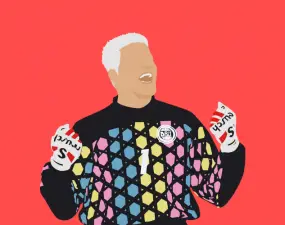The Intertoto Cup is a relic of European football – it’s been 12 years since its last edition. Here we take a look at the history of this bizarre competition, its myriad format changes, and some of the clubs and countries which fared best within its ever-changing parameters.
Context
Seasons come and go, and so do European football tournaments. The European Cup was established in 1955, with Real Madrid winning the first five editions. In 1971, the UEFA Cup was born, Tottenham Hotspur overcoming Wolverhampton Wanderers in Europe’s second-most prestigious competition. But these two competitions are the only evergreens still in existence today – albeit under different branding; the European Cup became the Champions League in 1992, and the UEFA Cup became the Europa League in 2009.
Dozens of other pan-continental tournaments have come and gone. The Mitropa Cup was founded way back in 1927, taking place 51 times between then and its deconstruction in 1992. For a time, it was the arguably the most prestigious club competition in world football, with the great Hungarian teams of the 50s lighting up the event.
The Copa Latina was another forerunner to the Champions League. An end of seasons competition contested by the winners of the French, Spanish, Italian and Portuguese champions, the tournament ran for eight seasons before 1949 and 1957.
In the future, Europe is set to see the introduction of the much-maligned UEFA Europa Conference League. This tournament will act as the third rung on the continent’s footballing ladder.
One of the more confusing attempts at a continental showpiece, however, was the UEFA Intertoto Cup – a source of puzzlement across Europe from its birth in 1961 to its final iteration in 2008.
The Early Years – How Did it Work?
To say the format for the Intertoto Cup was confusing is an understatement. Essentially, the tournament took place every summer and was a means for the pools – a football gambling format in a similar vein to the national lottery – to continue in the off-season. In fact, the etymology of “Intertoto” is rooted in the German translation of “pools.”
The tournament ran for 34 years before it was recognised and adopted by UEFA as an officially sanctioned competition. For the first six years, there was just one winner per edition. To enter the competition, teams had to send off an application to the competition’s officials and meet a set of criteria – most importantly, they would not be considered if they were already participating in another European Competition that season. This led to it being dubbed the “Cup for the Cupless.”
In the first six editions of the tournament, just one winner was crowned from 32 teams – although this number would fluctuate over the coming years. The competition started with eight groups of four. Teams would play each other twice, home and away, before the team who topped the group would progress to the two-legged quarter-finals, semi-finals and eventually final. By the end, the two teams who made the final would have played 12 games apiece – this was no trifling preseason tournament; it was almost a third of a Premier League season.
In the 63-64 tournament, the Intertoto Cup expanded to become a 48-club event. The following year it shredded a group to become a 44-team tournament, before returning to a 48 team format the next season. In the 66-67 iteration, it initially returned to its 32-team format before the officials changed their minds and added another two groups of four to make it a total of 40. In 1969 there were 36 competitors, and in 1970 a massive 52-team event took place. These manic fluctuations continued for the majority of the tournament’s history. And you thought the Nations League was confusing.
Things got even more baffling from 1967 onwards. After flirting with a regional system, the competition’s organisers decided that no outright winner would be declared. Instead, there would be anywhere from seven up to 12 winners – one from each group. No knockout matches would be played, though an informal “winner” was usually said to be the team with the best record from the group games.
From 1969 onwards, there was at least some stability. After three years with the regional format, this new system remained mostly unchanged for 25 years. The number of teams differed, of course, but the competition did at least have some sort of consistent identity. Prior to that, one wonders in what sense other than name the various iterations of the Intertoto Cup were linked. Although admittedly the same can be said of competitions like the European Cup/Champions League.
Modernisation and UEFA Recognition
In 1995, the competition underwent its most significant change. Europe’s chief football body, UEFA, took over the tournament. In doing so, they offered places in the more prestigious UEFA Cup to the competition’s victors.
This instantly made the competition more attractive. At first, two UEFA Cup places were allocated. This meant the knockout round format had to return. In the first edition since UEFA took control, the winners of 12 four-team groups advanced to the round-of-16 along with four of the best second-placed teams. The winners advanced to the quarters and then the semis. Once they reached this stage, the matches were subsumed by the UEFA Cup qualification process.
In 1996, UEFA allocated the Intertoto another UEFA Cup qualifying place, taking the number of teams who would play in the tournament as a result of winning the Intertoto Cup to three.
It had been a rollercoaster ride for this curious tournament in terms of format, but one last change was to come. In 2006, the competition reverted to a system similar to the one used between 64 and 94, with 11 Intertoto winners declared. Only this time, the spoils were far greater, with every single one of these 11 winners advancing to the qualification stage of the UEFA Cup. The accolade of outright Intertoto champion was given to the team that went furthest in the UEFA Cup.
It all came to an end in 2008, the competition’s original purpose – to give the pools a platform to continue throughout the summer – was now almost completely redundant.
The Football of the Intertoto Cup
The nature of competition throughout most of its existence dictated that rather than just one team being crowned winner, there was an abundance of champions. Taking into account both the UEFA-recognised and the non-UEFA-recognised editions, Czechoslovakia – a country that no longer exists – is the most successful nation, with 62 winners and 34 runners-up. The nation also boasts the second-most successful team in the form of Slovan Bratislava who won the competition eight times, with their first triumph coming all the way back in 1970 and their last in 1994.
The most successful team outright, however, is Malmö with ten titles. This is apt considering it was the Malmö president Eric Persson who first came up with the idea of the Intertoto Cup in the 60s.
His idea seemed to be a masterstroke when the first edition of the tournament happened to produce one of its finest matches, in the final no less, and also one of its most remarkable stories. Feyenoord progressed from Group B1 ahead of some tough opposition in the form of Schake 04, IFK Göteborg and La Chaux-de-Fonds. Their Dutch rivals, Ajax, were one of four Netherlands-based teams to play in that year’s Intertoto Cup. They qualified for the knockout rounds by the skin of their teeth, edging out Malmö by a single point in Group B2. With that being said, they were enormously impressive in all but the two games in which they dropped points, scoring 26 and conceding eight in six games.
Ajax edged past First Vienna in the quarters, and Feyenoord outclassed Sparta Dradec Kralove to ensure there would be a strong Dutch presence in the semis. Both teams prevailed in their encounters to set up a classic final between two of Europe’s fiercest rivals.
The final was held in Amsterdam. Ajax won 4-2, with Henk Groot scoring a hat-trick to secure the club’s first European trophy. The trophy in question is the source of a brilliant story, however. For years it was presumed missing, until none other than Edwin Van der Sar found it in an antique store in Notting Hill, London. How’s that for a coincidence?
In the competition’s modern format, VfB Stuttgart is the most successful club. They were outright winners first in 2000 when they beat Auxerre in the final over two legs. French opposition were the victims once more in 2002 when they beat Lille to advance to the UEFA Cup. Their third and final triumph came in the competition’s final edition in 2008 – though they were just one of 11 winners this time. Braga were the outright winners in that year’s tournament as they reached the round-of-16 in the UEFA Cup where they lost out to Paris Saint-Germain and restored some balance to the German-French equilibrium.
Those two nations are the most successful in the competitions modern format too, with 26 wins between them. France have had no less than 13 different winners and 16 triumphs in total. Germany have shared ten triumphs between six clubs.
Of the so-called “Big Five” of European Leagues, England have been the poorest in the Intertoto Cup. They first participated once the tournament was officially recognised by UEFA in 1995, dispatching Sheffield Wednesday, Wimbledon and Tottenham Hotspur to represent them.
West Ham United were the first English club to become outright winners when they beat Metz in 1999. This was shortly followed by an Aston Villa triumph in 2001 and victory for Fulham in 2002. However, on each occasion, these English teams were one of three winners of the Intertoto Cup. Newcastle United became the first and last outright winners of the competition from the country when they reached the last 16 of the UEFA Cup in 2006.




